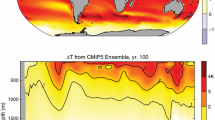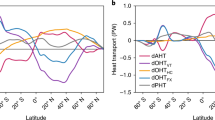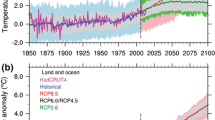Abstract
Climate changes during the next 100 years caused by anthropogenic emissions of greenhouse gases have been simulated for the Intergovernmental Panel on Climate Change Scenarios A (“business as usual”) and D (“accelerated policies”) using a coupled ocean-atmosphere general circulation model. In the global average, the near-surface temperature rises by 2.6 K in Scenario A and by 0.6 K in Scenario D. The global patterns of climate change for both IPCC scenarios and for a third step-function 2 x CO2 experiment were found to be very similar. The warming delay over the oceans is larger than found in simulations with atmospheric general circulation models coupled to mixed-layer models, leading to a more pronounced land-sea contrast and a weaker warming (and in some regions even an initial cooling) in the Southern Ocean. During the first forty years, the global warming and sea level rise due to the thermal expansion of the ocean are significantly slower than estimated previously from box-diffusion-upwelling models, but the major part of this delay can be attributed to the previous warming history prior to the start of present coupled ocean-atmosphere model integration (cold start).
Similar content being viewed by others
References
Bakan S, Chlond A, Cubasch U, Feichter J, Graf H, Graßl H, Hasselmann K, Kirchner I, Latif M, Roeckner E, Sausen R, Schlese U, Schriever D, Schult I, Schumann U, Sielmann F, Welke W (1991) Climate response to smoke from the burning oil wells in Kuwait. Nature 351:367–371
Boer GJ, Arpe K, Blackburn M, Deque M, Gates WL, Hart TL, Le Treut H, Roeckner E, Sheinin DA, Simmonds I, Smith RNB, Tokioka T, Wetherald RT, Williamson D (1991) An intercomparison of the climates simulated by 14 atmospheric general circulation models. WMO/TD-No 425, Geneva
Cess RD, Potter GL, Blanchet JP, Boer GJ, Ghan SJ, Kiehl JT, Le Treut H, Li ZX, Liang XZ, Mitchell JFB, Morcrette J-J, Randall DA, Riches MR, Roeckner E, Schlese U, Slingo A, Taylor KE, Washington WM, Wetherald RT, Yagai I (1989) Interpretation of could climate feedback as produced by 14 atmospheric general circulation models. Science 245:513–516
Broecker WS (1987) The biggest chill. Nat Hist Mag 97:74–82
Gordon AL (1986) Interocean exchange of thermocline water. J Geophys Res 91:5037–5046
Gordon AL, Piola AR (1983) Atlantic Ocean upper layer salinity budget. J Phys Oceanogr 13:1293–1300
Hall MM, Bryden HL (1982) Direct estimates and mechanisms of ocean heat transport. Deep-Sea Res 29A:339–359
Hansen J, Fung I, Lacis A, Rind D, Lebedeff S, Ruedy R, Russell G, Stone P (1988) Global climate changes as forecast by Goddard Institute for Space Studies three-dimensional model. J Geophys Res 93:9341–9364
Hasselmann K (1991) Ocean circulation and climate change. Tellus 43 AB: 82–103
Hasselmann K, Sausen R, Maier-Reimer E, Voss R (1992) On the cold start problem in transient simulations with coupled ocean-atmosphere models. MPI Report No 83, MPI für Meteorologie, Hamburg, FRG
Houghton JT, Jenkins GJ, Ephraums JJ (1990) Climate change. The IPCC Scientific Assessment, Cambridge University Press, Cambridge
Houghton JT, Callander BA, Varney SK (1992) Climate changes 1992. The supplementary report to the IPCC assessment. Cambridge University Press, Cambridge
Hsiung J (1985) Estimates of global oceanic meridional heat transport. J Phys Oceanogr 15:1405–1413
Lautenschlager M, Herterich K (1990) Atmospheric response to ice age conditions — climatology near the Earth's surface. J Geophys Res 95:22547–22557
Levitus S (1982) Climatological atlas of the World Ocean. NOAA Professional Paper 13, 173 pp
Liu Q, Schuurmanns CJE (1990) The correlation of tropospheric and stratospheric temperatures and its effect on the detection of climate changes. Geophys Res Lett 17:1085–1088
Maier-Reimer E, Hasselmann K (1987) Transport and storage of CO2 in the ocean — an inorganic ocean-circulation carbon cycle model. Clim Dyn 2:63–90
Maier-Reimer E, Mikolajewicz U (1989) Experiments with an OGCM on the cause of the Younger Dryas. In: Ayala-Castanares A, Wooster W, Yanez-Arancibia A (eds) Oceanography 1988. UNAM Press, Mexico, pp 87–100
Maier-Reimer E, Mikolajewicz U, Hasselmann K (1992) Mean circulation of the Hamburg LSG OGCM and its sensitivity to the thermohaline surface forcing. J Phys Oceanogr (accepted)
Manabe S, Bryan K, Spelman MJ (1990) Transient response of a global ocean-atmosphere model to a doubling of carbon dioxide. J Phys Oceanogr 20:722–749
Manabe S, Stouffer RJ, Spelman MJ, Bryan K (1991) Transient responses of a coupled ocean-atmosphere model to gradual changes of atmospheric CO2. Part I: annual mean response. J Climate 4:785–818
Mikolajewicz U, Maier-Reimer E (1990) Internal secular variability in an ocean general circulation model. Clim Dyn 4:145–156
Mikolajewicz U, Santer BD, Maier-Reimer E (1990) Ocean response to greenhouse warming. Nature 345:589–593
Mitchell JFB, Manabe S, Tokioka T, Meleshko V (1990) Equilibrium climate change. In: Houghton JT, Jenkins GJ, Ephraums JJ (eds) Climate change. The IPCC Scientific Assessment, Cambridge University Press, Cambridge, pp 131–172
Roeckner E, Dümenil L, Kirk E, Lunkeit F, Ponater M, Rockel B, Sausen R, Schlese U (1989) The Hamburg version of the ECMWF model (ECHAM). In: Boer GF (ed) Research activities in atmospheric and oceanic modelling. CAS/JSC Working Group on Numerical Experimentation 13:7.1–7.4 WMO Technical Document 322, Geneva
Roemmich D (1980) Estimation of meridional heat flux in the North Atlantic by inverse methods. J Phys Oceanogr 10:1972–1983
Sausen R, Barthel K, Hasselmann K (1988) Coupled ocean-atmosphere models with flux corrections. Clim Dyn 2:154–163
Schlesinger ME, Mitchell JFB (1987) Climate model simulations of the equilibrium climatic response to increased carbon dioxide. R Geophys 25:760–798
Stouffer RJ, Manabe S, Bryan K (1989) Interhemispheric asymmetry in climate response to a gradual increase of atmospheric CO2. Nature 342:660–662
Talley LD (1984) Meridional heat transport in the Pacific Ocean
Tibaldi S, Tosi E (1991) Low frequency variability and blocking as diagnostic tools for global climate models. In: Shukla J (ed) Proceedings of NATO Workshop on predictions of interannual climate variations. NATO/ASI Series, Trieste, 22-26/7/ 91
Washington WM, Meehl GA (1989a) Climate sensitivity due to increased CO2: experiments with a coupled atmosphere and ocean general circulation model. Clint Dyn 4:1–38
Washington WM, Meehl GA (1989b) Seasonal cycle experiments on the climate sensitivity due to a doubling of CO2 with an atmospheric general circulation model coupled to a simple mixed layer ocean model. J Geophys Res 89:9475–9503
Wetherald RT, Manabe S (1988) Cloud feedback processes in a general circulation model. J Atmos Sci 45:1397–1415
Wigley TML, Raper SCB (1987) Thermal expansion of seawater associated with global warming. Nature 330:127–131
Wigley TML, Santer BD (1990) Statistical comparison of spatial fields in model validation, perturbation and predictability experiments. J Geophys Res 95:851–865
Wilson CA, Mitchell JFB (1987) A doubled CO2 climate sensitivity experiment with a global climate model including a simple ocean. J Geophys Res 92:13315–13343
Xu J-S, Storch H, van Loon H (1990) The performance of four spectral GCMs in the Southern Hemisphere: the January and July climatology and the semiannual wave. J Climate 3:5370
Author information
Authors and Affiliations
Rights and permissions
About this article
Cite this article
Cubasch, U., Hasselmann, K., Höck, H. et al. Time-dependent greenhouse warming computations with a coupled ocean-atmosphere model. Climate Dynamics 8, 55–69 (1992). https://doi.org/10.1007/BF00209163
Accepted:
Issue Date:
DOI: https://doi.org/10.1007/BF00209163




